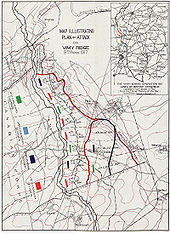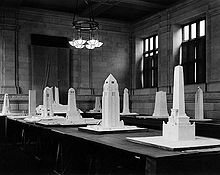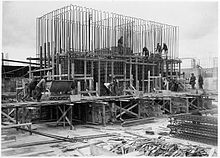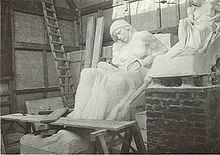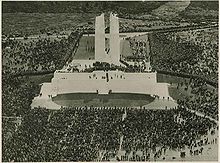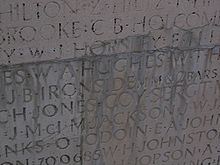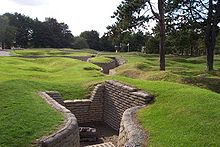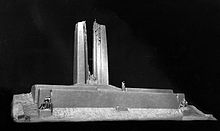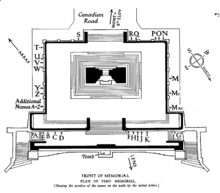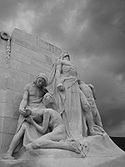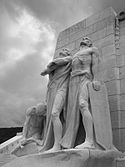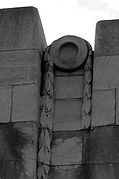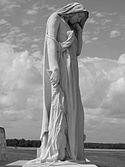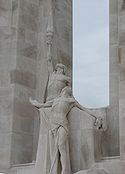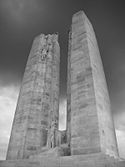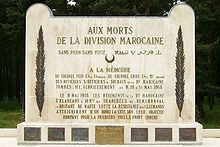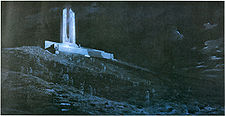- Canadian National Vimy Memorial
-
Canadian National Vimy Memorial Veterans Affairs Canada
Commonwealth War Graves Commission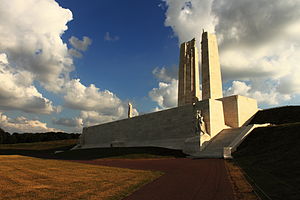
The front of the Vimy Memorial.For First World War Canadian dead and First World War Canadian missing, presumed dead in France. Unveiled 26 July 1936
By King Edward VIIILocation Coordinates: 50°22′46″N 02°46′25″E / 50.37944°N 2.77361°E near Vimy, Pas-de-Calais, France Designed by Walter Seymour Allward Total commemorated 11,169[Note 1] English: To the valour of their countrymen in the Great War and in memory of their sixty thousand dead this monument is raised by the people of Canada.
French: À la vaillance de ses fils pendant la Grande Guerre et en mémoire de ses soixante mille morts, le peuple canadien a élevé ce monument.Statistics source: Cemetery register: Details • Reports • Plans • Photographs. CWGC. The Canadian National Vimy Memorial is a memorial site in France dedicated to the memory of Canadian Expeditionary Force members killed during the First World War. It also serves as the place of commemoration for First World War Canadian soldiers killed or presumed dead in France who have no known grave. The monument is the centrepiece of a 250-acre (100 ha) preserved battlefield park that encompasses a portion of the grounds over which the Canadian Corps made their assault during the Battle of Vimy Ridge, a military engagement fought as part of the Battle of Arras.
The Battle of Vimy Ridge was the first occasion whereupon all four divisions of the Canadian Expeditionary Force participated in a battle as a cohesive formation, and thus became a Canadian nationalistic symbol of achievement and sacrifice. In recognition of Canada's war efforts, France granted Canada perpetual use of a portion of land on Vimy Ridge under the understanding that the Canadians use the land to establish a battlefield park and memorial. Wartime tunnels, trenches, craters and unexploded munitions still honeycomb the grounds of the site, which remains largely closed off for public safety. Along with preserved trench lines, there are a number of other memorials and cemeteries contained within the site.
The memorial took monument designer Walter Seymour Allward eleven years to build. King Edward VIII unveiled the memorial on 26 July 1936, in the presence of French President Albert Lebrun, 50,000 or more Canadian and French veterans, and their families. Following an extensive multi-year restoration, Queen Elizabeth II rededicated the memorial on 9 April 2007 during a ceremony commemorating the 90th anniversary of the battle. The memorial site is one of two National Historic Sites of Canada located outside of Canada and is maintained by Veterans Affairs Canada.
Contents
Background
Topography
Vimy Ridge is a gradually rising escarpment on the western edge of the Douai Plains, eight kilometres northeast of Arras. The ridge gradually rises on its western side, dropping more quickly on the eastern side.[2] The ridge is approximately seven kilometres in length and culminates at an elevation of 145 metres (476 ft) above sea level, or 60 metres (200 ft) above the Douai Plains, providing a natural unobstructed view for tens of kilometres in all directions.[2][3]
Early conflicts on site
The ridge fell under German control in October 1914, during the Race to the Sea, as the Franco-British and German forces continually attempted to outflank each other through northeastern France.[4] The French Tenth Army attempted to dislodge the Germans from the region during the Second Battle of Artois in May 1915 by attacking their positions at Vimy Ridge and Notre Dame de Lorette. During the attack, the French 1st Moroccan Division briefly captured the height of the ridge, where the Vimy memorial is currently located, but was unable to hold it owing to a lack of reinforcements.[5] The French made another attempt during the Third Battle of Artois in September 1915, but were once again unsuccessful in capturing the top of the ridge.[6] The French suffered approximately 150,000 casualties in their attempts to gain control of Vimy Ridge and surrounding territory.[7]
The British XVII Corps relieved the French Tenth Army from the sector in February 1916.[8] On 21 May 1916, the German infantry attacked the British lines along a 2,000-yard (1,800 m) front in an effort to force them from positions along the base of the ridge.[9] The Germans captured several British-controlled tunnels and mine craters before halting their advance and entrenching their positions.[9][Note 2] Temporary Lieutenant Richard Basil Brandram Jones was posthumously awarded the Victoria Cross for his ultimately unsuccessful defence of the Broadmarsh Crater during the attack.[11][Note 3] British counter-attacks on 22 May did not manage to change the situation.[9] The Canadian Corps relieved the British IV Corps stationed along the western slopes of Vimy Ridge in October 1916.[2]
Battle of Vimy Ridge
The Battle of Vimy Ridge was the first instance in which all four Canadian divisions participated in a battle together, as a cohesive formation.[12] The nature and size of the planned Canadian Corps assault necessitated support and resources beyond its normal operational capabilities.[13] Consequently, the British 5th Infantry Division and supplementary artillery, engineer and labour units reinforced the four Canadian divisions already in place. The 24th British Division of I Corps supported the Canadian Corps along its northern flank while the XVII Corps did so to the south.[14] The ad hoc Gruppe Vimy formation, based under I Bavarian Reserve Corps commander General der Infanterie Karl Ritter von Fasbender, was the principal defending formation with three divisions responsible for manning the frontline defences opposite the Canadian Corps.[15]
The attack began at 5:30 am on Easter Monday, 9 April 1917. Light field guns laid down a barrage that advanced in predetermined increments, often 100 yards (91 m) every three minutes, while medium and heavy howitzers established a series of standing barrages against known defensive systems further ahead.[16] The 1st, 2nd and 3rd Canadian Divisions quickly captured their first objectives.[17] The 4th Canadian Division encountered a great deal of trouble during its advance and was unable to complete its first objective until some hours later.[17] The 1st, 2nd and 3rd Canadian Division captured their second objective by approximately 7:30 am.[18][19][20] The failure of the 4th Canadian Division to capture the top of the ridge delayed further advances and forced the 3rd Canadian Division to expend resources establishing a defensive line to its north.[21] Reserve units from the 4th Canadian Division renewed the attack on the German positions on the top of the ridge and eventually forced the German troops holding the southwestern portion of Hill 145 to withdraw.[22][Note 4]
On the morning of 10 April, Canadian Corps commander Lieutenant-General Julian Byng moved up three fresh brigades to support the continued advance.[24] The fresh units leapfrogged units already in place and captured the third objective line, including Hill 135 and the town of Thélus, by 11:00 am.[25] By 2:00 pm both the 1st and 2nd Canadian Divisions reported capturing their final objectives.[26] By this point the "Pimple", a heavily defended knoll west of the town of Givenchy-en-Gohelle, was the only German position remaining on Vimy Ridge.[22] On 12 April, the 10th Canadian Brigade attacked and quickly overcame the hastily entrenched German troops, with the support of artillery and the 24th British Division.[27] By nightfall on 12 April, the Canadian Corps was in firm control of the ridge.[27] The Canadian Corps suffered 10,602 casualties: 3,598 killed and 7,004 wounded.[28] The German Sixth Army suffered an unknown number of casualties with an approximate 4,000 men becoming prisoners of war.[29]
The Battle of Vimy Ridge has considerable significance for Canada.[30] Although the battle is not generally considered Canada's greatest military achievement, the image of national unity and achievement gave the battle importance.[31] According to Pierce, "the historical reality of the battle has been reworked and reinterpreted in a conscious attempt to give purpose and meaning to an event that came to symbolize Canada's coming of age as a nation."[32] The idea that Canada's national identity and nationhood were born out of the battle is an opinion that is widely held in military and general histories of Canada.[33][34]
History
Selection
In 1920, the Government of Canada announced that the Imperial War Graves Commission had awarded Canada eight sites—five in France and three in Belgium—on which to erect memorials.[35][Note 5] Each site represented a significant Canadian engagement and the Canadian government initially decided that each battlefield be treated equally and commemorated with identical monuments.[35] In September 1920, the Canadian government formed the Canadian Battlefields Memorials Commission to discuss the process and conditions for holding a memorial competition for the sites in Europe.[37] The commission held its first meeting on 26 November 1920 and during this meeting decided that the architectural design competition would be open to all Canadian architects, designers, sculptors and artists.[36] Interested parties submitted 160 design drawings and the jury selected 17 submissions for consideration, commissioning each finalist to produce a plaster maquette of their respective design.[38] In October 1921, the commission selected the submission of Toronto sculptor and designer Walter Seymour Allward as the winner of the competition, and that of Frederick Chapman Clemesha as runner-up.[37] The complexity of Allward's design precluded the possibility of duplicating the design at each site.[39] The commission revised its initial plans and decided to build two distinctive memorials—that of Allward and Clemesha—and six smaller identical memorials.[39] At the outset, members of the commission debated where to build Allward's winning design.[37] Committee member and former Canadian Corps commander, Lieutenant-General Arthur Currie argued in favour of the government placing the monument in Belgium on Hill 62.[32][40] In the end, the commission selected Vimy Ridge as the preferred site, largely because of its elevation above the plain below.[41]
The government announced its desire to acquire a more considerable tract of land along the ridge after the commission selected Vimy Ridge as the preferred location for Allward’s design.[42] In the interval between the 1st and 2nd session of the 14th Canadian Parliament, Speaker of the Canadian House of Commons Rodolphe Lemieux went to France to negotiate the acquisition of more land.[42] In December 1922, Lemieux concluded an agreement with France in which France granted Canada "freely and for all time" the use of 250 acres (100 ha) of land on Vimy Ridge, in recognition of Canada's war effort.[43] The only condition placed on the donation was that Canada use the land to erect a monument commemorating Canadian soldiers killed during the First World War and assume the responsibility for the maintenance of the memorial and the surrounding battlefield park.[43]
Memorial construction
In 1924, the Canadian Battlefields Memorials Commission hired Dr. Oscar Faber, a Danish structural engineer, to prepare foundation plans as well as provide general supervision of the foundation work.[44] Major Unwin Simson served as the principal Canadian engineer during the construction of the memorial and oversaw much of the daily operations at the site.[45][46] Allward moved to Paris in 1925 to supervise the construction of the monument and the carving of the sculptures.[47] Construction of the memorial commenced in 1925 and took eleven years to complete.[48] The Imperial War Graves Commission concurrently employed French and British veterans to carry out the necessary roadwork and site landscaping.[47]
In June 1922, Allward set up a studio in London, England and toured for almost two years in an attempt to find a stone of the right colour, texture, and luminosity for the memorial.[46] He eventually found it in the ruins of the Diocletian's Palace. Allward observed that the palace had not weathered over the years, a fact that Allward took as evidence of the stone's durability.[46] Allward's choice, Seget limestone, came from an ancient Roman quarry located near Seget, Croatia.[49] The difficulties associated with the quarrying process, coupled with complicated transportation logistics, delayed delivery of the stone, which consequently delayed construction of the memorial.[46] The first shipment of stone did not arrive at the memorial site until 1927, and the larger blocks, intended for the human figures, did not begin to arrive until 1931.[46]
While awaiting the first delivery of stone, Simson noticed that the battlefield landscape features were beginning to deteriorate.[46] Seeing an opportunity to not only preserve a portion of the battlefield but also keep his staff occupied, Simson decided to preserve a short section of trench line as well make the Grange Subway more accessible.[46] Labourers rebuilt and preserved sections of sandbagged trench wall, on both the Canadian and German sides of the Grange crater group, in concrete.[46] The workforce also built a new concrete entrance for the Grange Subway and, after excavating a portion of the tunnel system, installed electric lighting.[46]
Allward chose a relatively new construction method for the monument; limestone bonded to a cast concrete frame. A foundation bed of 11,000 tonnes of concrete, reinforced with hundreds of tonnes of steel, served as the support bed for the memorial. The memorial base and twin pylons contained almost 6,000 tonnes of a Seget limestone.[50] Sculptors carved the 20 human figures on-site, from large blocks of stone. The carvers used half-size plaster models produced by Allward in his studio, now on display at the Canadian War Museum, and an instrument called a pantograph to reproduce the figures at the proper scale.[51] The carvers conducted their work year-round, inside temporary studios built around each figure.[52] The inclusion of the names of those killed in France with no known grave was not part of the original design and Allward was unhappy when the government subsequently asked him to include them.[53][Note 6] Allward argued that the inclusion of names was not part of the original commissioning.[53] Through a letter to Canadian Battlefields Memorials Commission in October 1927, Allward indicated his intention to relegate the names of the missing to pavement stones around the monument.[53] The collective dismay and uproar of the commission forced Allward to relent and incorporate the names of the missing on the memorial walls.[53] The task of inscribing the names did not begin until early 1930s and employed a typeface that Allward designed specifically for the monument.[46]
Pilgrimage and unveiling
In preparation for the 1936 Vimy Pilgrimage, the Government of Canada made a special Vimy passport available to pilgrims, at no extra cost.[54] On 16 July 1936, five trans-Atlantic liners departed the port of Montreal for the unveiling of the Canadian National Vimy Memorial in France.[Note 7] About 6,400 people sailed on the five steamships from Canada and 1,365 Canadians came from England.[56] Edward VIII, in his capacity as King of Canada, officially unveiled the monument on 26 July 1936.[57][58][59] The ceremony was one of the King's few official duties before he abdicated the throne.[58] Senior Canadian, British, and European officials, including French President Albert Lebrun, and over 50,000 Canadian, British, and French veterans and their families attended the event.[48] The ceremony included a guard of honour made of Royal Canadian Mounted Police officers, Royal Canadian Navy members with rifles, and flyovers by two Canadian squadrons and two French squadrons. Edward VIII gave a speech, starting in French and switching to English, thanking France for its generosity and assuring those assembled that Canada would never forget its war missing and dead. The king then pulled the Royal Union Flag from the central figure of Canada Bereft and the military band played the Last Post.[60]
Second World War
The general safety of the memorial was a cause for concern for the Canadian government. In 1939, the increased threat of conflict with Nazi Germany amplified the Canadian government’s level of concern.[45] Canada could do little more than protect the sculptures and the bases of the pylons with sandbags and await developments.[45] When war did break out, the British Expeditionary Force deployed to France and assumed responsibility for the Arras sector, which included Vimy.[45] In late May 1940, following the British retreat in the aftermath of the Battle of Arras, the status and condition of the memorial became unknown.[61] The Germans took control of the site and held the site's caretaker, George Stubbs, in an Ilag internment camp for Allied civilians in St. Denis, France.[62] The rumoured destruction of the Vimy Memorial, either during the fighting or at the hands of the Germans, was widely reported in both Canada and the United Kingdom.[63] The rumours eventually led the German Ministry of Public Enlightenment and Propaganda to publish denials.[64] Adolf Hitler even personally toured the Vimy Memorial and its preserved trenches on 2 June 1940, and was photographed doing so, to demonstrate the memorial had not been desecrated.[65] The undamaged state of the memorial was not conclusively confirmed until September 1944 when the Welsh Guards recaptured Vimy Ridge.[66]
Restoration and rededication
In May 2001, the Government of Canada announced the Canadian Battlefield Memorials Restoration Project, a major 30 million Canadian dollar restoration project to restore Canada's memorial sites in France and Belgium, in order to maintain and present them in a respectful and dignified manner.[67][68] In 2005, the Vimy memorial closed for major restoration work. Veterans Affairs Canada directed the restoration of the memorial in cooperation with other Canadian departments, the Commonwealth War Graves Commission, consultants and specialists in military history.[67]
Time, wear and severe weather conditions led to many identified problems, the single most pervasive problem being water damage.[67] In building a memorial made of cast concrete covered in stone, Allward had failed to take into account how these materials would shift over time.[68] The builders and designer failed to incorporate sufficient space between the concrete and stones, which resulted in water infiltrating the structure.[68] Over time, water entered the monument through its walls and platforms and coursed through the structure, dissolving lime from the concrete foundation and masonry.[67] As the water exited, it deposited lime on exterior surface walls obscuring many of the names inscribed on the memorial.[68] Poor drainage and water flows off the monument also caused significant erosion and deterioration to the platform, terrace and stairs.[67] The restoration project intended to address the root causes of the deterioration and included repairs to the stone, walkways, walls, terraces, stairs and platforms of the memorial.[67]
Queen Elizabeth II, escorted by Prince Philip, Duke of Edinburgh, rededicated the restored memorial on 9 April 2007 in a ceremony commemorating the 90th anniversary of the battle.[69] Other senior Canadian officials, including Canadian Prime Minister Stephen Harper, and senior French representatives, such as French Prime Minister Dominique de Villepin, attended the event, along with thousands of Canadian students, veterans of the Second World War and of more recent conflicts, and descendants of those who fought at Vimy.[70] The rededication ceremony comprised the largest crowd on the site since the 1936 dedication.[70]
Site
The Canadian National Vimy Memorial site is located approximately eight kilometres north of Arras, France, near the towns of Vimy and Neuville-Saint-Vaast. The site is one of the few places on the former Western Front where a visitor can see the trench lines of a First World War battlefield and the related terrain in a preserved natural state.[71][72] The total area of the site is 250 acres (100 ha), much of which is forested and off limits to visitors to ensure public safety. The site's rough terrain and unearthed unexploded munitions make the task of grass cutting too dangerous for human operators.[73] Instead, sheep graze the open meadows of the site.[74]
The site was founded to principally honour the memory of the Canadian Corps, but also contains a number of other memorials. These include memorials dedicated to the French Moroccan Division, Lions Club International and Lieutenant-Colonel Mike Watkins. There are also two Commonwealth War Graves Commission maintained cemeteries on site; Canadian Cemetery No. 2 and Givenchy Road Canadian Cemetery.[75][76] Beyond being a popular location for battlefield tours, the site is also an important location in the burgeoning field of First World War battlefield archaeology, because of its preserved and largely undisturbed state.[77] The site's interpretive centre helps visitors fully understand the Vimy Memorial, the preserved battlefield park and the history of the Battle of Vimy within the context of Canada's participation in the First World War.[78] The Canadian National Vimy Memorial and Beaumont-Hamel Newfoundland Memorial sites comprise close to 80 percent of conserved First World War battlefields in existence and between them receive over one million visitors each year.[79]
Vimy memorial
Allward constructed the memorial on the vantage point of Hill 145, the highest point on the ridge.[80] The memorial contains a large number of stylized features, including 20 human figures, which help the viewer in contemplating the structure as a whole. The front wall, normally mistaken for the rear, is 24 feet (7.3 m) high and represents an impenetrable wall of defence.[47] There is a group of figures at each end of the front wall, next to the base of the steps.[81] The Breaking of the Sword is located at the southern corner of the front wall while Sympathy of the Canadians for the Helpless is located at the northern corner.[82] Collectively, the two groups are The Defenders and represent the ideals for which Canadians gave their lives during the war.[82] There is a cannon barrel draped in laurel and olive branches carved into the wall above each group, to symbolize peace.[81][83] In Breaking of the Sword, three young men are present, one of whom is crouching and breaking his sword.[82] This statue represents the defeat of militarism and the general desire for peace.[84] This grouping of figures is the most overt image to pacifism in the monument, the breaking of a sword being extremely uncommon in war memorials.[85] The original plan for the sculpture included one figure crushing a German helmet with his foot.[47] Allward later decided to dismiss this feature because of its overtly militaristic imagery.[47] In Sympathy of the Canadians for the Helpless, one man stands erect while three other figures, stricken by hunger or disease, are crouched and kneeling around him. The standing man represents Canada’s sympathy for the weak and oppressed.[86]
The figure of a cloaked young female stands on top of the front wall and overlooks the Douai Plains. The woman has her head bowed, her eyes cast down, and her chin resting in one hand. Below her at ground level of the former battlefield is a sarcophagus, bearing a Brodie helmet, a sword and draped in laurel branches.[82] The saddened figure of Canada Bereft, also known as Mother Canada, is a national personification of the young nation of Canada, mourning her dead.[82][Note 8] The statue, a reference to traditional images of the Mater Dolorosa and presented in a similar style to that of Michelangelo's Pietà, faces eastward looking out to the dawn of the new day.[87] Unlike the other statues on the monument, stonemasons carved Canada Bereft from a single 30 tonne block of stone.[87] The statue is the largest single piece in the monument and serves as a focal point.[87]
The twin pylons rise to a height 30 metres above the memorial's stone platform. The twin white pylons, one bearing the maple leaf for Canada the other the fleur-de-lis for France, symbolize the unity and sacrifice of both countries.[81] At the top of two pylons is a grouping of figures known collectively as the Chorus.[67] The most senior figures represent Justice and Peace.[88] Peace stands with a torch upraised, making it the highest point in the region.[89] The pair is in a style similar to Allward's previously commissioned statues of Truth and Justice, located outside the Supreme Court of Canada in Ottawa.[90] The figures of Hope, Charity, Honour and Faith are located below Justice and Peace on the eastern side, with Truth and Knowledge on the western side. Around these figures are shields of Canada, Britain and France. Large crosses adorn the outside of each pylon.[83] The First World War battle honours of the Canadian regiments and a dedicatory inscription to Canada's war dead, in both French and English, also appear on the monument. The Spirit of Sacrifice is located at the base between the two pylons.[87] In the display, a young dying soldier is gazing upward in a crucifixion-like pose, having thrown his torch to a comrade who holds it aloft behind him.[87] In a lightly veiled reference to the poem In Flanders Fields by John McCrae, the torch is passed from one comrade to another in an effort to keep alive the memory of the war dead.[89]
It is an inspired expression in stone, chiselled by a skilful Canadian hand, of Canada's salute to her fallen sons.[91]
King Edward VIII referring to the memorial during his 1936 speech.The Mourning Parents, one male and one female figure, are reclining on either side of the western steps on the reverse side of the monument. They represent the mourning mothers and fathers of the nation and are likely patterned on the four statues by Michelangelo on the Medici Tomb in Florence, Italy.[90] Inscribed on the outside wall of the monument are the names of the 11,285 Canadians killed in France, and whose final resting place is unknown.[46] Most Commonwealth War Graves Commission memorials present names in a descending list format. Allward sought to present the names as a seamless list and decided to do so by inscribing the names in continuous bands, across both vertical and horizontal seams, around the base of the monument.[67] The memorial contains the names of four posthumous Victoria Cross recipients; Robert Grierson Combe, Frederick Hobson, William Johnstone Milne and Robert Spall.[92]
Elements of the Vimy Memorial The front wall representing an impenetrable wall of defence.Sympathy of the Canadians for the Helpless.Breaking of the SwordsCannons covered in laurel further symbolizing peace.Mother Canada mourning her dead.The stone sarcophagus representing Canada's war dead.The Spirit of Sacrifice passing the torch.The twin pylons representing France and Canada, partners in arms.The statues of The Chorus on the western side: Truth and Knowledge.Mourning Parents: the male.Mourning Parents: the female.Names of the missing carved on the memorial walls.Moroccan Division Memorial
The Moroccan Division Memorial is dedicated to the memory of the members of the French Moroccan Division killed during the Second Battle of Artois in May 1915.[5] General Victor d'Urbal, commander of the French Tenth Army, sought to dislodge the Germans from the region by attacking their positions at Vimy Ridge and Notre Dame de Lorette.[93] When the attack began on 9 May 1915, the French XXXIII Corps made significant territorial gains.[93] The Moroccan Division, which was part of the XXXIII Corps, quickly moved through the German defences and advanced 4 kilometres (4,400 yd) into German lines in two hours.[94] The division managed to capture the height of the ridge, with small parties even reaching the far side of the ridge, before retreating due to a lack of reinforcements.[5] Even after German counter-attacks, the division managed to hold a territorial gain of 2,100 metres (2,300 yd).[94]
Grange Subway
The First World War's Western Front included an extensive system of underground tunnels, subways and dugouts. The Grange Subway is a tunnel system that is approximately 800 metres (870 yd) in length and once connected the reserve lines to the front line. This permitted soldiers to advance to the front quickly, securely and unseen.[95] A portion of this tunnel system is open to the public through regular guided tours provided by Canadian student guides.[96]
The Arras-Vimy sector was conducive to tunnel excavation owing to the soft, porous yet extremely stable nature of the chalk underground.[95] As a result, pronounced underground warfare had been an active feature of the Vimy sector since 1915.[95] In preparation for the Battle of Vimy Ridge, five British tunnelling companies excavated 12 subways along the Canadian Corps' front, the longest of which was 1.2 kilometres (1,300 yd) in length.[97] The tunnellers excavated the subways at a depth of 10 metres to ensure protection from large calibre howitzer shellfire.[97] The subways were often dug at a pace of four metres a day and were often two metres tall and one metre wide.[95] This underground network often incorporated or included concealed light rail lines, hospitals, command posts, water reservoirs, ammunition stores, mortar and machine gun posts, and communication centres.[97]
Lieutenant-Colonel Mike Watkins memorial
Near the Canadian side of the restored trenches is a small memorial plaque dedicated to Lieutenant-Colonel Mike Watkins MBE. Watkins was head of Explosive Ordnance Disposal at the Directorate of Land Service Ammunition, Royal Logistics Corps and a leading British explosive ordnance disposal expert.[98] In August 1998, he died in a roof collapse near a tunnel entrance while undertaking a detailed investigative survey of the British tunnel system on the grounds of the Canadian National Vimy Memorial site.[98] Watkins was no stranger to the tunnel system at Vimy Ridge. Earlier the same year, he participated in the successful disarming of 3 tonnes of deteriorated ammonal explosives located under a road intersection on the site.[98]
Georges Devloo
The memorial site is accessible by car, taxi and tour bus, but not by public transport. Canadians looking for transportation used to be able to get rides from a senior resident of Vimy, Georges Devloo. Known as the Grandpa of Vimy to the Canadian guides, he would offer car rides to Canadian tourists to and from the memorial at no charge, as a way of paying tribute to the Canadians who fought at Vimy.[99] Devloo died in February 2009; he had been giving free rides to Canadians for 13 years.[100]
Sociocultural influence
The Canadian National Vimy Memorial site has considerable sociocultural significance for Canada. The idea that Canada's national identity and nationhood were born out of the Battle of Vimy Ridge is an opinion that is widely published in military and general histories of Canada.[33][34] Denise Thomson suggests that the construction of the Vimy memorial represents the culmination of an increasingly assertive nationalism that developed in Canada during the interwar period.[101] Meanwhile, Hucker suggests that the memorial transcends the Battle of Vimy Ridge and now serves as an enduring image of the whole of the First World War, while concurrently expressing the enormous impact of war in general.[102] Hucker also suggest that the most recent restoration project serves as evidence of a new generation's determination to remember Canada's contribution and sacrifice during the First World War.[102]
The Historic Sites and Monuments Board of Canada recognized the importance of the site by recommending its designation as a National Historic Site of Canada; it was so designated, one of only two outside of Canada, in 1997.[103] The other is the Beaumont-Hamel Newfoundland Memorial, also in France. In 1931, Will Longstaff painted Ghosts of Vimy Ridge, depicting ghosts of men from the Canadian Corps on Vimy Ridge surrounding the memorial, though the memorial was still several years away from completion.[104] The Canadian Unknown Soldier was selected from a cemetery in the vicinity of the Canadian National Vimy Memorial and the design of the Canadian Tomb of the Unknown Soldier is based upon the stone sarcophagus at the base of the Vimy memorial.[105]
A 2001 Canadian bestselling historical novelThe Stone Carvers by Jane Urquhart involves the characters in the design and creation of the memorial. In 2007, the memorial was a short listed selection for the Seven Wonders of Canada.[106] The Royal Canadian Mint released commemorative coins featuring the memorial on a number of occasions, including a 5 cent sterling silver coin in 2002 and a 30 dollar sterling silver coin in 2007. The Sacrifice Medal, a Canadian military decoration created in 2008, features the image of Mother Canada on the reverse side of the medal.[107] A permanent bas relief sculpted image of the memorial is presented in the gallery of the grand hall of the Embassy of France in Canada to symbolize the close relations between the two countries.[108]
Notes
- ^ It is not possible to remove the names of those whose bodies have been discovered or identified since the construction of the memorial. As a result, there are a number of individuals who are commemorated on both the memorial and by a headstone.[1] Although 11,285 names appear on the memorial only 11,169 are commemorated as missing.
- ^ The Germans grew uneasy about the proximity of the British positions to the top of the ridge, particularly after the increase in British tunnelling and counter mining activities.[9][10]
- ^ The Broadmarsh Crater remains visible and is located within the grounds of the Canadian National Vimy Memorial Park.
- ^ German records indicate that the defending German units withdrew because they had fully run out of ammunition, mortar rounds and grenades.[23]
- ^ The eight sites were Vimy, Bourlon Wood, Le Quesnel, Dury and Courcelette in France, and St. Julien, Hill 62 (Sanctuary Wood) and Passchendaele in Belgium.[36]
- ^ The government was acting on behalf of a request by the Imperial War Graves Commission which was tasked with commemorating all killed and missing Commonwealth soldiers and was, as a result, prepared to share in the cost of the memorial.[53]
- ^ The ships were the SS Montrose, SS Montcalm, SS Antonia, SS Ascania and the SS Duchess of Bedford.[55]
- ^ Dancer turned model Edna Moynihan served as the model with the statue itself being carved by Italian Luigi Rigamonti.[46]
Footnotes
- ^ "Private Herbert Peterson". Veterans Affairs Canada. 4 April 2007. http://www.vac-acc.gc.ca/remembers/sub.cfm?source=feature/vimy90/events/hpeterson. Retrieved 5 January 2010.
- ^ a b c Farr p. 147
- ^ Rose & Nathanail pp. 396–397, Fig. 14.3
- ^ Boire (2007) pp. 52–53
- ^ a b c Boire (2007) p. 56
- ^ Tucker p. 68
- ^ Turner p. 8
- ^ Boire (1992) p. 15
- ^ a b c d Samuels pp. 200–202
- ^ Sheldon p. 149
- ^ "Victoria Cross List Tells Heroic Deeds" (PDF). New York Times (The New York Times Company). 21 August 1916. http://query.nytimes.com/mem/archive-free/pdf?_r=1&res=9504E7D81E3FE233A25752C2A96E9C946796D6CF. Retrieved 17 September 2009.
- ^ Cook p. 120
- ^ Nicholson (1962) p. 229
- ^ Turner p. 39
- ^ Williams p. 149
- ^ Cook p. 117
- ^ a b Nicholson (1962) p. 254
- ^ Nicholson (1962) p. 255
- ^ Campbell pp. 178–179
- ^ Hayes p. 200
- ^ Hayes pp. 202–203
- ^ a b Godefroy (2007a) p. 220
- ^ Sheldon p. 309
- ^ Campbell pp. 179
- ^ Campbell pp. 179–181
- ^ Campbell p. 182
- ^ a b Nicholson (1962) p. 263
- ^ Moran p. 139
- ^ Gibbs, Philip (11 April 1917). "All of Vimy Ridge Cleared of Germans" (PDF). New York Times (The New York Times Company). http://query.nytimes.com/gst/abstract.html?res=9904E2DE153AE433A25752C1A9629C946696D6CF. Retrieved 14 November 2009.
- ^ Inglis p. 1
- ^ Vance p. 233
- ^ a b Pierce p. 5
- ^ a b Inglis p. 2
- ^ a b Humphries p. 66
- ^ a b Busch p. 205
- ^ a b "Canadian Battlefields Memorials Committee". Veteran Affairs Canada. 25 March 2007. http://www.vac-acc.gc.ca/remembers/sub.cfm?source=Memorials/can_battle_committee. Retrieved 12 January 2008.
- ^ a b c Vance p. 66
- ^ "Design Competition". Veteran Affairs Canada. 25 March 2007. http://www.vac-acc.gc.ca/remembers/sub.cfm?source=memorials/ww1mem/vimy/sg/01_artwork/04_competition. Retrieved 12 January 2008.
- ^ a b Vance p. 67
- ^ Hucker p. 283
- ^ Vance pp. 66–69
- ^ a b Inglis p. 61
- ^ a b "Canada Treaty Information". Department of Foreign Affairs and International Trade. 26 February 2002. http://www.treaty-accord.gc.ca/text-texte.asp?id=102661. Retrieved 4 January 2008.
- ^ Hucker p. 285
- ^ a b c d Durflinger p. 292
- ^ a b c d e f g h i j k l Hucker p. 286
- ^ a b c d e Pierce p. 6
- ^ a b "The Battle of Vimy Ridge — Fast Facts". VAC Canada Remembers. Veterans Affairs Canada. n.d.. http://www.vac-acc.gc.ca/remembers/sub.cfm?source=memorials/ww1mem/vimy/battle. Retrieved 26 March 2009.
- ^ Fabijančić p. 127
- ^ Picard (online)
- ^ Busch p. 206
- ^ "Design and Construction of the Vimy Ridge Memorial". Veterans Affairs Canada. 12 August 1998. http://www.vac-acc.gc.ca/remembers/sub.cfm?source=memorials/ww1mem/vimy/vmemory. Retrieved 14 November 2009.
- ^ a b c d e Duffy p. 197
- ^ MacIntyre p. 197
- ^ "Dedication of the Canadian National Vimy Memorial". Veterans Affairs Canada. 19 January 2007. http://www.vac-acc.gc.ca/remembers/sub.cfm?source=feature/vimy90/media/backgrounders/1936dedication. Retrieved 14 November 2009.
- ^ MacIntyre p. 159
- ^ Bell, Bousfield and Toffoli p. 139
- ^ a b Foot, Richard (4 April 2007). "Vimy memorial had a turbulent history of its own". The Vancouver Sun (Vancouver): p. A4.
- ^ Lloyd p. 221
- ^ Morton & Wright p. 221
- ^ Durflinger p. 293
- ^ Durflinger p. 300
- ^ Durflinger p. 294
- ^ Durflinger p. 297
- ^ (2000). "Remembrance: The Canadian Unknown Soldier". In: After The Battle, 109. ISSN 0306-154X.
- ^ Durflinger p. 298
- ^ a b c d e f g h Valpy, Micheal (7 April 2007). "Setting a legend in stone". Globe and Mail (Toronto). http://www.theglobeandmail.com/archives/article752525.ece. Retrieved 28 April 2009.
- ^ a b c d Hucker p. 288
- ^ Bell, Bousfield and Toffoli p.140
- ^ a b Tom Kennedy, CTV National News, 9 April 2007.
- ^ Rose & Nathanail p. 216
- ^ Lloyd p. 120
- ^ "Annual Report 2007-2008" (PDF). Commonwealth War Graves Commission. 2008. p. 16. http://www.cwgc.org/admin/files/Annual%20Report%202007-08%20Part1.pdf. Retrieved 10 January 2010.
- ^ Turner p. 7
- ^ "CWGC :: Cemetery Details - Canadian Cemetery No. 2, Neuville-St. Vaast". Commonwealth War Graves Commission. n.d.. http://www.cwgc.org/search/cemetery_details.aspx?cemetery=2103985&mode=1. Retrieved 13 March 2009.
- ^ "CWGC :: Cemetery Details - Givenchy Road Canadian Cemetery, Neuville-St. Vaast". Commonwealth War Graves Commission. n.d.. http://www.cwgc.org/search/cemetery_details.aspx?cemetery=68402&mode=1. Retrieved 13 March 2009.
- ^ Saunders pp. 101–108
- ^ "Interpretive Centre at the Canadian National Vimy Memorial". Veterans Affairs Canada. 22 March 2007. http://www.vac-acc.gc.ca/remembers/sub.cfm?source=memorials/ww1mem/vimy/interpret. Retrieved 14 November 2009.
- ^ "Canadian Battlefield Memorials Restoration Project". Veterans Affairs Canada. 19 January 2007. http://www.vac-acc.gc.ca/remembers/sub.cfm?source=feature/vimy90/media/backgrounders/cbmrbackground. Retrieved 13 March 2009.
- ^ Busch p. 12
- ^ a b c Brandon p. 10
- ^ a b c d e Hucker p. 282
- ^ a b Hopkins p. 188
- ^ Bolling p. 310
- ^ Prost p. 316
- ^ MacIntyre p. 156
- ^ a b c d e Duffy p. 194
- ^ Brandon p. 13
- ^ a b Nicholson (1973) p. 33
- ^ a b Brandon p. 12
- ^ "John Mould Diaries : Return to Vimy". Archives of Ontario. n.d.. http://www.archives.gov.on.ca/english/on-line-exhibits/mould/vimy.aspx. Retrieved 4 January 2010.
- ^ "Victoria Cross (VC) Recipients". Veterans Affairs Canada. 31 November 2007. http://www.vac-acc.gc.ca/remembers/sub.cfm?source=feature/vimy90/media/backgrounders/vimyvc. Retrieved 5 January 2010.
- ^ a b Simkins p. 48
- ^ a b Doughty p. 159
- ^ a b c d Rose & Nathanail p. 398
- ^ Turner p. 90
- ^ a b c Barton p. 200
- ^ a b c Beaver, Paul (14 August 1998). "Obituary: Lt-Col Mike Watkins". The Independent (London). http://www.independent.co.uk/arts-entertainment/obituary-ltcol-mike-watkins-1171486.html. Retrieved 26 April 2009.
- ^ Harris, Kathleen (13 November 2009). "'Grandpa of Vimy' gives rides for sweets". London Free Press (Sum Media Corp).
- ^ Arsenault, Adrienne (10 February 2009). "Au revoir to the grand-père of Vimy". Canadian Broadcasting Company. http://www.cbc.ca/world/story/2009/02/09/f-rfa-arsenault.html. Retrieved 10 February 2009.
- ^ Thomas p. 5–27
- ^ a b Hucker p.280
- ^ "Canadian National Historic Site Designation". Veterans Affairs Canada. 9 September 1999. http://vac-acc.gc.ca/remembers/sub.cfm?source=memorials/ww1mem/vimy/vimycerm. Retrieved 10 January 2010.
- ^ "Will Longstaff's Menin Gate at midnight (Ghosts of Menin Gate)". Australian War Memorial. n.d.. http://www.awm.gov.au/encyclopedia/menin/notes.asp. Retrieved 11 January 2010.
- ^ "Designing and Constructing". Veterans Affairs Canada. 5 May 2000. http://www.vac-acc.gc.ca/remembers/sub.cfm?source=Memorials/tomb/thetomb/tombconstruct. Retrieved 8 January 2010.
- ^ "Vimy Memorial, France". Canadian Broadcasting Company. n.d. http://www.cbc.ca/sevenwonders/wonder_vimy.html. Retrieved 7 January 2010.
- ^ "New military medal to honour combat casualties". Canadian Broadcasting Company. 29 August 2008. http://www.cbc.ca/canada/story/2008/08/29/sacrifice-medal.html?ref=rss&Authorized=1&AuthenticationKey=1_45_4c64df9a-89f8-4b1a-94ac-8efd26447be0.pakdllcidpafph. Retrieved 7 January 2010.
- ^ "Embassy of France in Canada, virtual visit". Embassy of France in Canada. January 2004. http://www.ambafrance-ca.org/gallery/genese/pages/vimy.htm. Retrieved 10 January 2010.
References
- Barton, Peter; Doyle, Peter; Vandewalle, Johan (2004). Beneath Flanders Fields: The Tunnellers' War 1914-1918. Montreal & Kingston: McGill-Queen's University Press. ISBN 0773529497. http://books.google.ca/books?id=wLZjfmkh3jYC&lpg=PP1&dq=Beneath%20Flanders%20Fields%3A%20The%20Tunnellers'%20War%201914-1918&pg=PP1#v=onepage&q&f=true.
- Bell, Lynne; Bousfield, Arthur; Toffoli, Gary (2007). Queen and Consort:Elizabeth and Philip - 60 Years of Marriage. Toronto: Dundurn Press. ISBN 978-1-55002-725-9. http://books.google.ca/books?id=sqFPntVyzK4C&lpg=PP1&dq=Queen%20and%20Consort%3AElizabeth%20and%20Philip%20-%2060%20Years%20of%20Marriage&pg=PP1#v=onepage&q&f=true.
- Boire, Michael (Spring 1992). "The Underground War: Military Mining Operations in support of the attack on Vimy Ridge, 9 April 1917" (PDF). Canadian Military History (Laurier Centre for Military Strategic and Disarmament Studies) 1 (1–2): 15–24. http://www.wlu.ca/lcmsds/cmh/back%20issues/CMH/volume%201/issue%201-2/Boire%20-%20The%20Underground%20War.pdf. Retrieved 2 January 2009.
- Boire, Michael (2007). "The Battlefield before the Canadians, 1914-1916". In Hayes, Geoffrey; Iarocci, Andrew; Bechthold, Mike. Vimy Ridge: A Canadian Reassessment. Waterloo: Wilfrid Laurier University Press. pp. 51–61. ISBN 0889205086. http://books.google.ca/books?id=Pf5y7sehRwAC&lpg=PP1&dq=Vimy%20Ridge%3A%20A%20Canadian%20Reassessment&pg=PA51#v=onepage&q&f=true.
- Bolling, Gordon (2003). "Acts of (Re-)Construction: Traces of Germany in Jane Urquhart's Novel the Stone Carvers". In Antor, Heinz; Brown, Sylvia; Considine, John et al.. Refractions of Germany in Canadian Literature and Culture. Berlin: de Gruyter. pp. 295–318. ISBN 978-3-11-017666-7. http://books.google.com/?id=CEocfbvIMMMC&printsec=frontcover&dq=Refractions+of+Germany+in+Canadian+Literature+and+Culture#v=onepage&q&f=true.
- Brandon, Laura (2006). Art or memorial? : The Forgotten History of Canada's War Art. Calgary: University of Calgary Press. ISBN 1552381781.
- Busch, Briton Cooper (2003). Canada and the Great War: Western Front Association Papers. Montreal: McGill-Queen's University Press. ISBN 077352570X. http://books.google.ca/books?id=LLKqAyUl6TAC&lpg=PP1&dq=Canada%20and%20the%20Great%20War%3A%20Western%20Front%20Association%20Papers&pg=PP1#v=onepage&q&f=true.
- Campbell, David (2007). "The 2nd Canadian Division: A 'Most Spectacular Battle'". In Hayes, Geoffrey; Iarocci, Andrew; Bechthold, Mike. Vimy Ridge: A Canadian Reassessment. Waterloo: Wilfrid Laurier University Press. pp. 171–192. ISBN 0889205086. http://books.google.ca/books?id=Pf5y7sehRwAC&lpg=PA171&dq=The%202nd%20Canadian%20Division%3A%20A%20'Most%20Spectacular%20Battle'&pg=PA171#v=onepage&q&f=true.
- Cook, Tim (2007). "The Gunners of Vimy Ridge: 'We are Hammering Fritz to Pieces'". In Hayes, Geoffrey; Iarocci, Andrew; Bechthold, Mike. Vimy Ridge: A Canadian Reassessment. Waterloo: Wilfrid Laurier University Press. pp. 105–124. ISBN 0889205086. http://books.google.ca/books?id=Pf5y7sehRwAC&lpg=PA171&dq=The%202nd%20Canadian%20Division%3A%20A%20'Most%20Spectacular%20Battle'&pg=PA105#v=onepage&q&f=true.
- Doughty, Robert A. (2005). Pyrrhic Victory: French Strategy and Operation in the Great War. Cambridge and London: Belknap Press. ISBN 067401880X. http://books.google.ca/books?id=vZRmHkdGk44C&lpg=PP1&dq=Pyrrhic%20Victory%3A%20French%20Strategy%20and%20Operation%20in%20the%20Great%20War&pg=PP1#v=onepage&q&f=true.
- Duffy, Denis (Summer 2008). "Complexity and contradiction in Canadian public sculpture: the case of Walter Allward". American Review of Canadian Studies (Routledge) 38 (2): 189–206. doi:10.1080/02722010809481708. http://findarticles.com/p/articles/mi_hb009/is_2_38/ai_n29452626/. Retrieved 1 June 2009.
- Durflinger, Serge (2007). "Safeguarding Sanctity: Canada and the Vimy Memorial during the Second World War". In Hayes, Geoffrey; Iarocci, Andrew; Bechthold, Mike. Vimy Ridge: A Canadian Reassessment. Waterloo: Wilfrid Laurier University Press. pp. 291–305. ISBN 0889205086.
- Fabijančić, Tony (2003). Croatia: Travels in Undiscovered Country. University of Alberta. ISBN 0888643977. http://books.google.com/?id=sppa_IWNmosC&printsec=frontcover. Retrieved 2 January 2009.
- Farr, Don (2007). The Silent General: A Biography of Haig's Trusted Great War Comrade-in-Arms. Solihull: Helion & Company Limited. ISBN 187462299. http://books.google.ca/books?id=70hVl257oPIC&lpg=PP1&dq=The%20Silent%20General%3A%20A%20Biography%20of%20Haig's%20Trusted%20Great%20War%20Comrade-in-Arms&pg=PP1#v=onepage&q&f=true.
- Godefroy, Andrew (2007). "The German Army at Vimy Ridge". In Hayes, Geoffrey; Iarocci, Andrew; Bechthold, Mike. Vimy Ridge: A Canadian Reassessment. Waterloo: Wilfrid Laurier University Press. pp. 225–238. ISBN 0889205086. http://books.google.ca/books?id=Pf5y7sehRwAC&lpg=PA171&dq=The%202nd%20Canadian%20Division%3A%20A%20'Most%20Spectacular%20Battle'&pg=PA225#v=onepage&q&f=true.
- Hayes, Geoffrey (2007). "The 3rd Canadian Division: Forgotten Victory". In Hayes, Geoffrey; Iarocci, Andrew; Bechthold, Mike. Vimy Ridge: A Canadian Reassessment. Waterloo: Wilfrid Laurier University Press. pp. 193–210. ISBN 0889205086. http://books.google.ca/books?id=Pf5y7sehRwAC&lpg=PA171&dq=The%202nd%20Canadian%20Division%3A%20A%20'Most%20Spectacular%20Battle'&pg=PA193#v=onepage&q&f=true.
- Hopkins, J. Castell (1919). Canada at War, 1914–1918: A Record of Heroism and Achievement. Toronto: Canadian Annual Review.
- Hucker, Jacqueline (2007). "The Meaning and Significance of the Vimy Monument". In Hayes, Geoffrey; Iarocci, Andrew; Bechthold, Mike. Vimy Ridge: A Canadian Reassessment. Waterloo: Wilfrid Laurier University Press. pp. 279–290. ISBN 0889205086. http://books.google.ca/books?id=Pf5y7sehRwAC&lpg=PA171&dq=The%202nd%20Canadian%20Division%3A%20A%20'Most%20Spectacular%20Battle'&pg=PA279#v=onepage&q&f=true.
- Humphries, Mark Osborne (2007). ""Old Wine in New Bottles": A Comparison of British and Canadian Preparations for the Battle of Arras". In Hayes, Geoffrey; Iarocci, Andrew; Bechthold, Mike. Vimy Ridge: A Canadian Reassessment. Waterloo: Wilfrid Laurier University Press. pp. 65–85. ISBN 0889205086.
- Inglis, Dave (1995). Vimy Ridge: 1917-1992, A Canadian Myth over Seventy Five Years. Burnaby: Simon Fraser University. http://ir.lib.sfu.ca/bitstream/1892/8002/1/b17448906.pdf. Retrieved 2 February 2009.
- Lloyd, David (1998). Battlefield tourism: pilgrimage and the commemoration of the Great War in Britain, Australia and Canada, 1919–1939. Oxford: Berg Publishing. ISBN 1859731740.
- MacIntyre, David (1967). Canada at Vimy. Toronto: Peter Martin Associates.
- Moran, Heather (2007). "The Canadian Army Medical Corps at Vimy Ridge". In Hayes, Geoffrey; Iarocci, Andrew; Bechthold, Mike. Vimy Ridge: A Canadian Reassessment. Waterloo: Wilfrid Laurier University Press. pp. 139–154. ISBN 0889205086.
- Morton, Desmond; Wright, Glenn (1987). Winning the Second Battle: Canadian Veterans and the Return to Civilian Life, 1915-1930. Toronto: University of Toronto Press.
- Nicholson, Gerald W. L. (1962) (PDF). Official History of the Canadian Army in the First World War: Canadian Expeditionary Force 1914–1919. Ottawa: Queen's Printer and Controller of Stationary. http://www.cmp-cpm.forces.gc.ca/dhh-dhp/his/docs/CEF_e.pdf. Retrieved 1 January 2007.
- Nicholson, Gerald W. L. (1973). “We will remember…”: Overseas Memorials to Canada’s War Dead. Ottawa: Minister of Veterans Affairs for Canada.
- Picard, Andréa (May 2006). "Restoring Loss at Vimy". Canadian Architect (Business Information Group). http://www.cdnarchitect.com/issues/ISArticle.asp?aid=1000204056&issue=05012006. Retrieved 1 August 2009.
- Pierce, John (Spring 1992). "Constructing Memory: The Vimy Memorial" (PDF). Canadian Military History (Laurier Centre for Military Strategic and Disarmament Studies) 1 (1–2): 4–14. http://www.wlu.ca/lcmsds/cmh/back%20issues/CMH/volume%201/issue%201-2/Pierce%20-%20Constructing%20Memory%20-%20The%20Vimy%20Memorial.pdf. Retrieved 2 February 2009.
- Prost, Antoine (1997). "Monuments to the Dead". In Nora, Pierre; Kritzman, Lawrence; Goldhammer, Arthur. Realms of memory: the construction of the French past. New York: Columbia University Press. pp. 307–332. ISBN 0231106343. http://books.google.ca/books?id=_Va9svbIgLwC&lpg=PP1&dq=Realms%20of%20memory%3A%20the%20construction%20of%20the%20French%20past%201997&pg=PA307#v=onepage&q&f=true.
- Rose, Edward; Nathanail, Paul (2000). Geology and Warfare: Examples of the Influence of Terrain and Geologists on Military Operations. London: Geological Society. ISBN 0850524636. http://books.google.ca/books?id=OEdlfb1VnMUC&lpg=PP1&dq=Geology%20and%20Warfare%3A%20Examples%20of%20the%20Influence%20of%20Terrain%20and%20Geologists%20on%20Military%20Operations&pg=PP1#v=onepage&q&f=true.
- Samuels, Mart (1996). Command or Control?: Command, Training and Tactics in the British and German Armies, 1888–1918. Portland: Frank Cass. ISBN 0714645702.
- Saunders, Nicholas (2002). "Excavating memories: archaeology and the Great War, 1914–2001". Antiquity (Portland Press) 76 (291): 101–108.
- Sheldon, Jack (2008). The German Army on Vimy Ridge 1914-1917. Barnsley (UK): Pen & Sword Military. ISBN 9781844156801.
- Simkins, Peter; Jukes, Geoffrey; Hickey, Michael (2002). The First World War: The Western Front, 1917-1918. Osprey Publishing. ISBN 9781841763484. http://books.google.ca/books?id=EB3ABsBOAgYC&lpg=PP1&dq=The%20First%20World%20War%3A%20The%20Western%20Front%2C%201917-1918&pg=PP1#v=onepage&q&f=true.
- Thomas, Denise (Winter 1995-1996). "National Sorrow, National Pride: Commemoration of War in Canada, 1918-1945". Journal of Canadian Studies 30 (4): 5–27. http://findarticles.com/p/articles/mi_qa3683/is_199501/ai_n8719631/pg_5/.
- Tucker, Spencer, ed (1996). The European powers in the First World War: an encyclopedia. New York: Garland Publishing. ISBN 0815303998. http://books.google.ca/books?id=EHI3PCjDtsUC&lpg=PP1&dq=The%20European%20powers%20in%20the%20First%20World%20War%3A%20an%20encyclopedia&pg=PP1#v=onepage&q&f=true.
- Turner, Alexander (2005). Vimy Ridge 1917: Byng's Canadians Triumph at Arras. London: Osprey Publishing. ISBN 1841768715.
- Vance, Jonathan Franklin (1997). Death So Noble: Memory, Meaning, and the First World War. Vancouver: UBC Press. ISBN 0774806001. http://books.google.ca/books?id=3wABF2KyvXEC&lpg=PP1&dq=Death%20So%20Noble%3A%20Memory%2C%20Meaning%2C%20and%20the%20First%20World%20War&pg=PP1#v=onepage&q&f=true.
- Williams, Jeffery (1983). Byng of Vimy, General and Governor General. London: Secker & Warburg. ISBN 0436571102.
External links
- Vimy Memorial—Veteran Affairs Canada
- The Vimy Foundation
- CBC: Remembering Vimy Ridge
- CBC Archives: King Edward VIII's speech at the dedication ceremony
Canadian First World War Memorials In Europe Canadian Expeditionary Force Memorials in France Courcelette Memorial · Dury Memorial · Canadian National Vimy Memorial · Bourlon Wood Memorial · Le Quesnel MemorialMemorials in Belgium Hill 62 (Sanctuary Wood) Memorial · Passchendaele Memorial · Saint Julien Memorial · Menin Gate MemorialRoyal Newfoundland Regiment Memorials in France Beaumont-Hamel Newfoundland Memorial · Gueudecourt Memorial · Monchy-le-Preux Memorial · Masnières MemorialMemorials in Belgium Courtrai Memorial National Historic Sites of Canada by location
National Historic Sites of Canada by locationProvinces Territories Northwest Territories · Nunavut · YukonOther countries France Category ·
Category ·  Portal ·
Portal ·  WikiProjectCategories:
WikiProjectCategories:- Canadian military memorials and cemeteries
- World War I memorials in France
- First World War in the Pas-de-Calais
- Monuments and memorials in the Pas-de-Calais
- National Historic Sites of Canada
- Canada–France relations
- Canada in World War I
- Walter Seymour Allward
Wikimedia Foundation. 2010.


